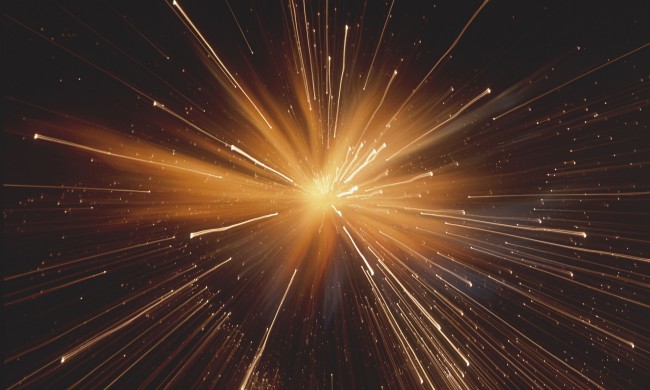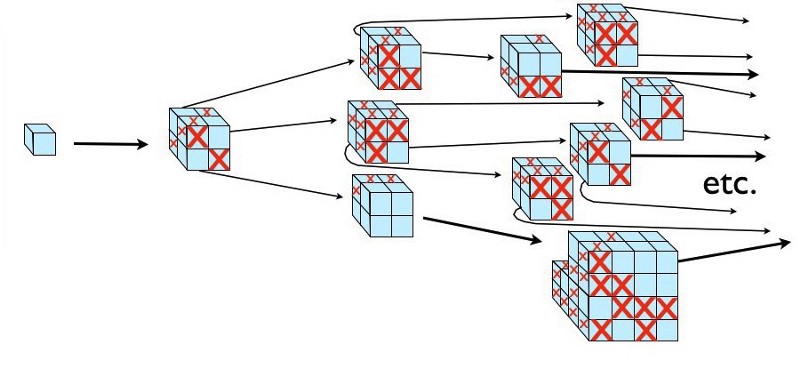
There is something in common at the beginning of our Universe, period of cosmic inflation, and the cause of her ultimate fate: the accelerating expansion of dark energy that can not lead to the idea that they are related. And here’s a question: if the hypothesis of eternal inflation is correct, can the dark energy be preceded by a return to it’s original state?
Not only that, it is possible that it may not even require eternal inflation. Let’s start with talking about the scene that preceded the birth of the famous and beloved of the Universe: cosmic inflation.

When the universe is full of matter and radiation — it came with a few strange properties: it was spatially flat, had one temperature everywhere, had no relicts of extremely high energy and had a very pronounced set of regions of higher and lower density. Perhaps the universe has already begun with this set of conditions, but the idea of cosmic inflation is that the universe began with a period of exponential expansion, in which a huge amount of energy was inherent to the space, and then the period ended and gave rise to the Big Bang with all these conditions. It took several years to accurately work out all the sequences, and even more time to find the fluctuations of the cosmic microwave background that confirmed cosmic inflation theory now iron, with which we begin the history of the Universe.
Eternal inflation is an offshoot of inflation, based on the property about which we rarely think. Usually, when you meet natural transition — like pots of hot water, which passes from the liquid to gaseous state — it starts in different places, gradually expanding and merging into one. In the case of boiling water, we call it percolation, seepage, when small bubbles appear and coalesce, creating large blisters on the surface. But inflation is the problem: in some regions, inflation did not stop at a certain point and continues, which prevents percolation in regions where inflation has stopped. This implies that our observable universe must be in the same bubble where inflation has ended, and not to consist of numerous bubbles that seep together.

Illustration of eternal inflation: where there is red cross, inflation ends and gives rise to the Big Bang; and there were the blue cubes, inflation continues. Mathematically, to allow inflation to create our Universe, inflation should continue indefinitely in the future
At the other end of the spectrum we have the fact that the expansion of the Universe is accelerating. The best explanation for that, with all available precision, would be that the space has a small energy component: we call it dark energy. This component of energy is present everywhere — in all points of space and is very small: if you turn it into a mass according to the Einstein formula E = mc2, it will be equivalent to one proton per cubic meter of the Universe. But space in space is not just huge, it is still expanding. So over time, this dark energy becomes increasingly important. After 8 billion years from the beginning of the Universe it has led to the fact that the expansion was accelerating, and later became the dominant component of the energy of the Universe.
Two of these period may seem very different: inflation and the accelerated expansion that has come with time. In fact, the magnitude of these energy scales differ 10120 times, and it’s a lot. But they both represent the energy inherent in space itself, both cause the fabric of space to expand exponentially and provided sufficient time — fractions of a second for inflation and trillion years of dark energy — I’ll take everything that is not connected to the Universe in a single structure, and burst to pieces. There is a whole class of models, known as quintessence, which try to unify inflation and dark energy.
What is the probability that our universe will “recycle” themselves, will conclude the cycle? Here are two good options.
- If dark energy is indeed cosmological constant, it could be residual, relict energy of the inflationary period from which it started. And if so, then there’s no reason why with the passage of sufficient time she did not go to much lower energy state. Perhaps this transition will lead to the fact that many Malapascua particles — neutrinos, for axions, or more exotic particles, will merge in their own versions of the stars, planets or even people. If we are unavailable, this does not mean that it is impossible, and this is one of the possible fates of our Universe in the distant future, even if it will take hugely years.
- Dark energy may not be a cosmological constant, and may increase in strength over time. If so, it will grow and grow until they lead to the scenario of the “big break” when each associated structure in the Universe will eventually burst into pieces. But the script, written by Eric Avisera possible that in the final moment before the space itself will crack the hell is this energy inherent in space, indistinguishable in inflationary scenarios, will be performed… in a hot Big Bang. This scenario of “rejuvenation of the Universe” may not only be possible in the distant future, but also significantly sostarivayut our Universe — perhaps it is infinitely old.
So far, our best evidence indicates that dark energy is the cosmological constant, thereby eliminating the second scenario. If there is no low-energy state for the transition, the first scenario can also be excluded, but we know enough to rule out both.
The answers to these questions should help us to find the EUCLID mission, NASA WFIRST and LSST (large survey telescope).
According to the materials of Ethan Siegel
